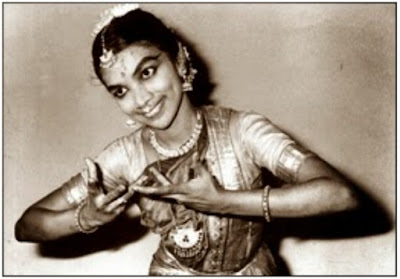 |
| Miranda Hemalatha |
Digested the disappointment, Saanvi
returned to her daily normality.
School until two and then at home to help aunt Komala, the personal moment of joy in the courtyard to dance, a tour in the village, and the evening appointment with the teledrama while sipping the iguru dapu*.
Next year she would try to enroll in
some school in Negombo, she had already told her mother about this and she
agreed too – for now she continued practicing in the backyard and it was enough
for her to smile every day.
When she didn't go to the beach or
along the river, she stayed with her aunt the whole time, in their empathic
harmony. She obviously missed her mother so much, but she thought she was lucky
to have met Komala. Some evenings Saanvi and her aunt talked for a long time in
the kitchen lit by a small light bulb, grinding the spices and cooking the roti
for the next day, among the badairingu* and the rolled paduru
hanging from the roof. They talked and joked, imitating the amorous arguments
of the teledrama, and laughed like two little girls. Her aunt made idiyappam
every morning before going to school.
With each week that she spent, Saanvi seemed to become more and more as a young woman.
Rani was able to visit her at least
once a month. She had told that after the early days when her uncle kept
shouting and ranting at her, he lately seemed to have resigned himself to the
idea of Saanvi's new life, and had stopped talking about marriage. He worked
less and less and drank more: he had become a swollen skin on the table snoring
and exhaling arack fumes.
When there was a puja, Saanvi and
her aunt went to Pallansena Three-well Taxi station and took a tuktuk which
brought them to Negombo in twenty minutes, to get off a few kilometers earlier
at Sri Singama Kali Amman Kovil on Sea Street, dedicated to the god Ganesh.
Saanvi looked up to the top of the large tree growing in the entrance courtyard
and the colorful statues on the tower and entrance; they took some coconuts and
smashed them on the ground in a small sacred ditch before entering the kovil
and praying together.
She still happened to hear some
comments about her or glare as she walked around the village and the pola,
but she began to forget about it: Saanvi had the dance and, as her aunt told her,
she was getting better every day.
Anuradha knew Komala's house well,
not too far from the route from her school to the market, and sometimes she made a
small detour in the late afternoon after class was over.
She didn't quite know the reason for
those extra steps either.
As she walked, she glanced over the
walls that encircled the courtyard and continued towards the market. One day
she heard a foot strike the ground, which she knew well, and saw hands appearing
beyond the corner of the house wall, then she walked around the courtyard and,
without being seen, stopped to watch Saanvi perform some Bharatanatyam
movements.
The following afternoon, at the same
time, Anuradha was again there admiring Saanvi, in silence. Until one evening
Komala, returning from the market, noticed her presence behind the courtyard
wall and went towards her; Anuradha had not even noticed Komala approaching:
she suddenly felt her behind and the voice almost made her jump: “My granddaughter
has become good, right teacher?”
Anuradha immediately regained
control of the expression on her face and body, turned to Komala and she gave a
little nod of the head in agreement.
“Take her to my school tomorrow.”
She said in a firm voice.
“Truly?” Aunt asked with a
white-toothed smile that lit up her face. Anuradha nodded as she stepped aside
and walked briskly away.
Komala said nothing to Saanvi, they ate a nice plate of parippu* together and went to sleep courted by the saltiness that perfumed the air.
 |
| Sri Lanka, 1880 |
The following afternoon it seemed
strange to Saanvi that her aunt would ask her to go out together, this rarely
happened except to go to the kovil, but they were not expected to go that day.
When the girl was missing two alleys,
the idea of the destination began to arise but she did not understand the
reason.
They stopped in front of the school
entrance which resounded with notes and claps of hands and feet like the
soundbox of a veena.
Saanvi looked at her aunt with a
confused and even a little annoyed expression. Komala stroked her hair and
smiling gave her a push.
“Go. Go. Today is your first day of
class.”
“But, nanda!? How...?” Saanvi
replied almost putting her feet on the ground so as not to advance.
The voice that came from the door
was an even stronger blow to pity Saanvi as she sailed through confusion like
an oruvas in a storm.
“Come on, we are waiting for you.”
The girl turned and saw Anuradha in
a sari on the doorstep of the school. Then Saanvi hastened towards her, bent
down at her feet, and greeted her with joined hands.
“Ayubowan, Guruthumi.”
Then she looked back at her aunt for
a last goodbye and followed the teacher into the school.
As soon as they entered the large
bright room, Anuradha told Saanvi to go and sit on the ground among the
students.
“Say hello to Saanvi, your new
companion.”
Some of them made room; a girl
apparently of the same age motioned her to sit beside. As soon as Saanvi sat
down she smiled and introduced herself: “My name is Isuri”, and they both
nodded their heads.
She was a skinny child, with a long
face and fair skin, with thick eyebrows and curly black hair.
Anuradha clapped her hands to get
attention.
“Well! Since we have a new student
with us, before starting I will do a brief review of the essential features of
the Bharatanatyam dance.”
She, therefore, positioned herself
erect in front of the students, with her chin raised and the gaze steady.
“A Bharatanatyam program is a set of
movements, rhythms, articulated facial expressions, hand gestures, body
movements, and other gestures. All this can be grouped into six items: alaripu,
jathisvaram, sabda, varna, padam, tillana accompanied by concluding slokas.
"Alaripu is a dance of invocation. Its name in Telegu
dialect means 'flowering', therefore it means 'to make the body bloom,' that is
to prepare for the next number.
"Jathisvaram is the second number of the program
and is a combination of 'jhati' and 'svara', i.e. first the jhati or rhythmic
syllables are performed and according to this the rhythms of the drums are
beaten. In the Natya Sastra, the meaning of this dance has been described as 'simple beauty' because it is the purest dance: that is, it does not respond to
any specific need other than to create beauty.
"Sabdam is the first dance form to introduce
expression or abhinaya to the viewer. It is an interpretive dance with a
religious or erotic feeling.
"Varnam is the most interesting and at the same time
most difficult part of a Bharatanatyam program. Its name, which means 'that is
colored,' indicates its function in dance. For each line of the song the dance
sequences are performed through a few movements and at the end, the climax is
reached.
"It is followed by the padam
which contains six or seven padas per performance, or the song of six or
seven lines whose meaning is interpreted by means of abhinaya. Here the dancer
deals exclusively with hand gestures and body expression.”
As she explained, Anuradha moved her
hands, fingers, or feet with an elegance that left Saanvi mesmerized and breathless.
What struck her about the teacher was her constant control and detachment, her
persistent ability to hide the slightest emotion.
“Then there is tillana, which
is a pure dance with complicated rhythms for the feet, thanks to which a dancer
shows all her skill.
"Finally, there is the conclusion of
the program with sloka: that is, the recitation of a short verse in
Sanskrit without rhythm or music.
"You must never forget: this is an
absolutely expressive dance, which includes the body, face, and hand mudras. The
asamyukta hasta are mudras performed with one hand and the samyukta
hasta is those with two. Concerning abhinaya of the face, Bharatanatyam counts
nine types of head movements, nine pupil movements, eight different looks,
eight eyelash movements, seven eyebrow movements, six nose movements, six types
of cheek movements, six types of lip movements, seven types of chin movements,
nine neck movements, four types of face coloring...”
Saanvi was finally in front of the
immense ocean of knowledge of what she had always loved, and not in front of a
simple transistor box like she had been forced to since childhood.
“Well, in position!” Anuradha said.
Each pupil got up and ran to bow
before the teacher, touching her feet in the gesture of respect called guru
wandana (bow to the teacher). Some of them who had not yet worn the salangai
went to get them and give to Anuradha who brought to her face and blessed them,
whispering: “Budu saranai (May Buddha bless you)”.
Saanvi also went to the salangai
on the ground, near the wall, but Anuradha stopped her: “You don't. It's not
time yet.”
The girl nodded and got into
position with the rest of the students.
She never forgot that first lesson.
Saanvi attended dance school every
day, except on weekends. With 250 rupees a month she was shaping her dreams,
and to think that at RIO she could not have bought Sundae Special.
Isuri became her best friend. Her
family had been from Duwana for generations and her father was an excellent
fisherman. She had started dancing for a year and was attending the “Ave Maria
Convent” Catholic School on Chilaw Road. Komala was very happy with their
friendship and often invited Isuri to watch television all together.
They both had a passion for the sea.
On weekends, when the uncle returned to be together in Komala, the two of them
spent many hours together, away from home. They sat astride the twisted trunks
of mangroves with their feet in the water of the river, following the
trajectories of the black-headed ibises on the water, while the shrill cries of
parrots or scimitar garrulli bounced from one side of the forest to the
other. Or they would run around the boats chased by stray dogs on the beach,
and then fall exhausted and happy on the sand with their noses turned to the
clouds in the sky: the rains would arrive early, in May, with the southwest
monsoons.
On Sundays, Saanvi waited for her
outside the church, after mass, and they ran to play until evening.
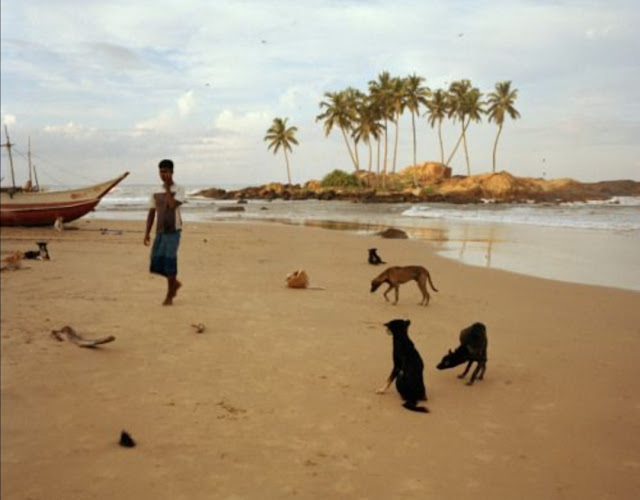 |
| Sri Lanka. © Bruno Barbey |
Anuradha had to admit that Saanvi
was a fast learner and had become one of her best students in a few months. Her
aunt was right about it, she was gifted for dance, but she had realized it when
she spied the girl dancing alone in the backyard, without ever having attended school.
After the first month, she took her
to the kovil with aunt Komala to have the salangai blessed by the
brahmin; then after symbolically asking her aunt's permission, instead of her
mother, to be able to dance, she received the blessing from Anuradha who bent
down at her feet and put her salangai around her ankles for the first
time.
Parents often came to pick up their
daughters at the end of classes.
It was then that the father of a
pupil, seeing Saanvi going out with the group, said in a contemptuous voice turned
towards Anuradha: “We also missed the little terrorist in class! Do you at
least check her belt when she walks in? Isn't it that she blows herself up with
the whole school?”
Saanvi's blood ran cold; she stood
still amidst the embarrassment of the other girls. Then Anuradha went towards
the man, she looked at him so intently that the other expectant parents took a
step back, and she replied with controlled but harsh emotion: “Here the only
terrorist is you with your tongue. Don't you dare speak like this again in
front of my pupils, in my school, in my house!”
The man grabbed his daughter's hand,
pulled her with him and spitting on the ground he said before going away: “You
really talk!”
The girls tried to console Saanvi in
chagrin, even though she smiled a little, giving the impression that nothing
had happened; then she walked away with the head down on the way home.
Anuradha followed her out of the
corner of the eye as she greeted the pupils one by one.
The following Saturday Komala peeked
into the kitchen where her niece was cooking roti for lunch between the hatti*,
knowing that uncle would be here shortly.
“Yes, nanda?” The girl said.
“Look who's there,” aunt smiled, and
behind her appeared Anuradha in a beautiful white saree with gold edges. Saanvi
was stunned, quickly wiped her hands in a rag, and went to the teacher to greet
her, but Anuradha stopped her before she bowed: “Come with me.”
The girl looked at her aunt as if
asking permission. Komala with her hands folded on her round belly rocked the head
smiling with white teeth.
They walked to Pallansena Three-well
Taxi station and took an emerald tuktuk adorned with bells and silver
loudspeakers that took up half of the driver's cabin.
“Where are we going, Guruthumi?”
“Then you will see,” Anuradha replied
with a half-smile.
The tuktuk proceeded briskly on the
road that skirted the beach of Negombo. Saanvi, resigned to the mystery of
their destination, abandoned herself to the landscape that ran beside and the
sea breeze that caressed her face, while the speakers pumped the sweet lines of
an old folk song.
සූරිය යනෙන රථ ඇණ ඉගි ලුනා දො
වීරිය කරන රාහුට අසු උනා දො
සූරිය උදා නූනෙ එම නිසාදො
(Suriya Sunera went round twice
The sun is setting
Rahu who was working hard got caught
Is that why the sun does not rise?)
After a quarter of an hour, the
tuktuk began to slow down on Temple Road as it approached a building from here
stood a white stupa and Buddha's head. The girl, getting out of the vehicle,
looked at Anuradha in a confused way: “But this is a pansala...”
The teacher took her hand and
nodded: “Yes, this is the Angurukaramulla Raja Maha Viharaya Temple, my
favorite, where I always come to pray. Come...”
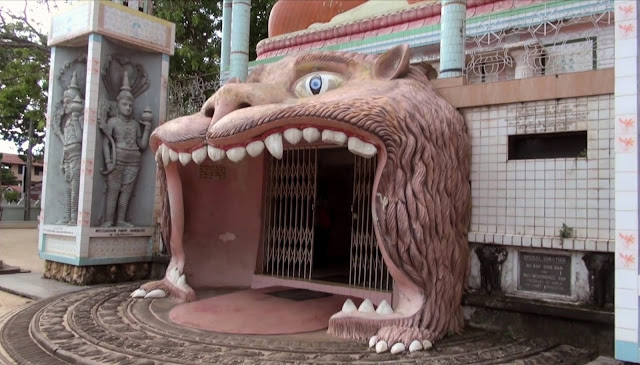 |
| Angurukaramulla Raja Maha Viharaya Temple |
“But Guruthumi... I'm not a
Buddhist.” Saanvi told her in disorientation.
“It doesn't matter, follow me!” The
woman answered decisively and they both went through the gate, with the girl
looking around curiously, especially at that entrance surrounded by the
dragon's jaws, at the foot of the six-meter-high Buddha statue, which is said
to protect the temple and its devotees from evil spirits, with a pool of water
in front of it. Inside the park, they walked into the wide open spaces
surrounded by trees and Saanvi leaned over the pond to see the turtles. A large
white stupa was adjacent to the temple, with statues of two bronze lions
standing on pedestals at the base of its staircase. Inside the stupa, there were
numerous paintings and sculptures, as well as carved walls and window
decorations. Saanvi looked at everything without saying a word, ecstatic.
Anuradha handed her a lighted candle
and they went in front of the statue of Buddha lying on the side.
“What do I have to do?" Saanvi asked
naively.
“Pray, as you wish,” Anuradha
replied, for the first time since she had known her, in a sweeter tone of
voice. Then she stroked her round face with a finger. The teacher bowed so that
she could look her straight into the eyes, in that steady way that was her
characteristic.
“Do you know that we Buddhists
follow the dharma, the teaching of Buddha, which is contained in the
Four Noble Truths and whose starting point is to recognize that life is
suffering, and that it is up to us to embark on the path that takes us away
from that suffering? As long as you remain chained to the hatred from which you
come, here...”, she said while with the tip of the index finger pressed to the
left of her chest, “...you will always feel hatred and that you will attract:
it is the law of karma. You have to accept who you are and open yourself
to the world. Become fluid, free. Let the hate slip away from you. Only in this
way, dance will live within you, because dance is harmony. That's why I brought
you here today. Harmony is the peaceful and melodious coexistence of different
notes. You see, the same people who offend and insult you, in the past, were
Tamils. It was a local bishop, Edmund Peiris, who ordered to change the means
of education from Tamil to Sinhala: despite the distinction between Sinhalese
and Tamils today is so marked, in the not too distant past these ethnic groups
were merged, especially on this west coast between Negombo and Puttalam, where
most of the villagers, although they call themselves Sinhalese, still speak
Tamil and are undoubtedly of Tamil origin. You think that the Negombo dialect
of the Tamil language is spoken by perhaps 50,000 people who identify
themselves as Sinhalese! We are all the coexistence of different histories,
languages, religions, but we are all children of the same land: we are Sri
Lankans! You understood?” Anuradha asked with a smile.
Saanvi, with tears in her eyes,
nodded, clutching the candle tightly in the hands; then they both turned to the
statue of Buddha and each recited their prayers in silence.
By now the season was about to end.
Anuradha informed the students that
the courses would resume after a few months, with the start of the new school
year.
She also added that in one of
Negombo's most famous and exclusive dance academies, the Bhashini Nruthya Kala
Dance Academy, an entrance exam would be held for the following year and the
director, Anuradha's friend, had asked her if she had any applications to do
from her school.
“I proposed you as a candidate for
this year, Saanvi,” she said, and all the students turned to look at the girl
who looked like a wax statue.
“Me?” It was the only word she
managed to say.
Anuradha nodded: “In three days we
will go to Negombo and you will perform for the admission test.”
Her joy was overwhelming. She jumped
into the house like a cricket with Komala trying to calm her down.
“Look how you break your leg before
the audition!” She would tell as she went after her in every corner of the
room.
She managed to let her mother know
too and Rani promised her that she would come for that day.
The night before the audition,
Saanvi couldn't believe the sight of uncle Sarvananthan's van parking in front
of the house and seeing her cousins get out, whom she hadn't seen for years, her
mother.
Uncle bent over her like an elephant
and pinching her arm, he muttered with
his usual arack-soaked breath: “But once the Academy is over, promise you will
look for a husband!”
Saanvi burst out laughing: “Bappa!
I don't even know if I can get in!”
In the evening they all ate together
and slept on the ground, all pressed but happy.
 |
| 1934 |
The Academy was a huge elegant
building with sober colors.
The inner hall was full of people,
entire families of candidates who came from all corners of Sri Lanka. In front
of the stage a row of red chairs on which the teachers were seated and in the
center the director, Miss Bhashini Thamesha Herath, a beautiful woman with a
stern face, white complexion and long straight black hair in a vermilion red
saree.
Several girls and a few boys performed
in different dance styles, from classical Kanadyan to Indian styles Kathak,
Kuchipudi and Bharatanatyam.
Saanvi waited in the back with
Anuradha and the other quivering candidates, salangai in her hands
sweaty from the nervousness.
A boy motioned her to get ready
because it would be her turn at the end of the performance in progress.
The girl began to tremble, she
almost no longer felt her legs; as she gave to Anuradha salangai to have
her blessing, she whispered in a vibrant voice: “What if it happens to me like
the first time I came to school? If I get stuck? What if I lose the rhythm?”
Her tears streamed down her dark
cheeks.
Anuradha bent at her feet and tied
the salangai; then she still on her knees wiped her tears away with a
finger and grabbed tightly on Saanvi's arms.
“Listen. Do you remember what we
said to each other at the Buddhist temple? This is your time! You know why you
chose what you have to dance, right? It's one of the most difficult.”
Saanvi nodded vigorously.
“You will dance Aigiri Nandini,
one of the most powerful stotrams composed by Adi Sharkaracharya, in which the
dance calms the fury of Sakthi Durga after killing the asura Mahishasura, the
demonic buffalo. This is your chance to kill once and for all the demon within
you, the fear, and start a new life. Go, my baby. Dance before Shiva.”
Saanvi sniffed, nodded again,
squeezed tightly the string that tied the ponytail of her hair, and entered the
stage.
She turned to the statue of Naṭarāja
beside her and looked straight ahead, into the magma of unrecognizable faces
among the beams of light aimed at her.
Then the music started and Saanvi
started dancing.
She is self-confident. Of what she
had become.
The mudras of the hands followed the
music while the expressions of the eyes changed according to the narration.
“Sinjitha Mohitha Bhoothapathe”, and the impact of the foot on the
ground actually produced a melodious sound of the anklet, as in the verse.
“Jaya hey mahishasura mardini
ramyaka pardini shailasuthe”
Like a fire, Anuradha's voice burned
in her whole body.
Naditha Natya Sugaanarathe”
Shiva also is mesmerized by the
beauty of the cosmic dance and stands with one foot raised, like Saanvi.
Property.
The demon had been defeated.
When she stopped there was a moment
that seemed to last forever, while the blood still pumped furiously in the
veins of the temples and chest, with the sweat beading her face. Then she
opened her eyes and saw that the whole hall was standing applauding, she could
also see that her buffalo uncle was standing
clapping vigorously.
She immediately turned to the side
of the stage where she saw Anuradha with her hands clasped and fingertips on her lips nodding her head.
Saanvi was one of five out of forty
candidates to be admitted. She would move to Negombo in a small accommodation
paid for by the Academy.
The greetings in the school were
intense and moving. By now a great friendship was born among them all. Saanvi
hugged Anuradha and thanked her for everything she had done for her, promising that
she would come back to see her whenever she could, after all, it was just thirty
minutes by tuktuk.
She set off with Isuri towards home;
she would also miss her, and their afternoons in the mangroves or running on
the sand between the boats.
A few steps from Komala's home,
Isuri looked at her and breathed a long sigh.
“Anyway, it was a miracle!”
Saanvi slapped her hard on Isuri's
arm and burst into laughter: “Hey! But what a miracle! Look, I deserved
admission! Do you want to imply that I didn't dance well?”
“Not at all!” Isuri answered angrily
as she rubbed the arm and in her serious voice said: “I didn't mean that. I was
saying, thinking about it, it was a miracle that Guruthumi accepted you in her
school, that she took you as her pupil, here...”
Saanvi shook her head.
“But what does this have to do with
it? Why?”
“But how, don't you know? Didn't
your aunt or Guruthumi ever tell you?”
Isuri replied while still stroking
her arm.
Saanvi stared straight into her
eyes: “No, said what?”
Then Isuri lowered her eyes a little
and in a slightly melancholy voice, she continued: “Guruthumi was once married.
She also had a daughter who was about our age, I forgot her name. At the time
they lived in Colombo. Husband with her daughter were at the Central Bus
Station in Pettah when the car bomb exploded by the LTTE on April 21, 1987:
they were two of the 113 victims. That's why she moved to live in this small
village and opened the dance school.”
It seemed to Saanvi that the entire
Indian Ocean was rising from the bottom of her heart towards the eyes. Without
saying anything she turned and started running as fast as she could. She
arrived at the school when there was no one left; she ran into the hall where
Anuradha was closing the windows.
She didn't have time to say anything
that Saanvi was holding her very tightly with the face pressed to her chest,
weeping bitterly as if a plow were plowing through her soul.
“Thanks, Guruthumi. Thanks for
everything...”
She repeated with the voice bent with
incessant weeping.
Then Anuradha stroked her face with
both hands and smiled sweetly at her.
“I will never forget you! Never!”
Saanvi screamed with part of her
face pressed to the teacher's chest.
“Me neither. Now go your own way and
build your destiny: dance!”
Saanvi later became one of Sri
Lanka's most celebrated Bharatanatyam dancers, where she opened several
schools, and also performed in America, France, India, and Japan. To the delight
of her uncle, she married a teacher and lived in Colombo with her three
children. Anuradha taught until the age forced her to retire but she never
closed the school: all of Duwana's children were free to go dance in that hall
without paying a rupee, until her death. She has never missed a Saanvi show.
Isuri became a journalist and has
met Saanvi several times to interview her and remember their childhood past.
With the money she was starting to earn, Saanvi bought a house for her elderly
mother Rani and a brand new TV for Komala.
Saanvi Academy went down in history with
the name “The Star of Shiva”
Oh, I forgot. The meaning of the
name Anuradha is precisely star.
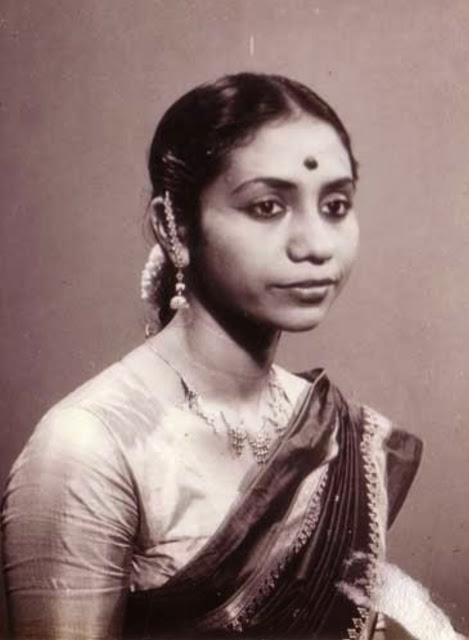 |
| Thiripurasundari Yoganantham |
P.S.
Special thanks go to those who helped me write this story.
First of all to teachers, Chanchala and Shiromi.
Thanks also to Bianca, Bhagya, Asanka, Natasha and Nilani, Ruwan and his mother.
I recommend my favorite version of the dance "Aigiri Nandini"
in the choreography of Sayani Chakraborty:
A great help also from Nivii's Vlog to understand daily life in Jaffna:
*Iguru dapu is
the famous Sri Lankan ginger tea.
*The badairingu
or dried corn was stored in the dummassa, a wooden rack that was built right
above the kitchen hearth or stove to keep it longer. If the quantity of the
product was small, it was tied together and hung from the ceiling of the
kitchen roof.
*Parippu is a
typical dish of Sri Lankan and Indian cuisine that combines basmati rice with
dahl, or a stew of red lentils, for this recipe is cooked in coconut milk and with
many spices.
*Hatti is a clay pot with a very wide but short neck.
Italian version

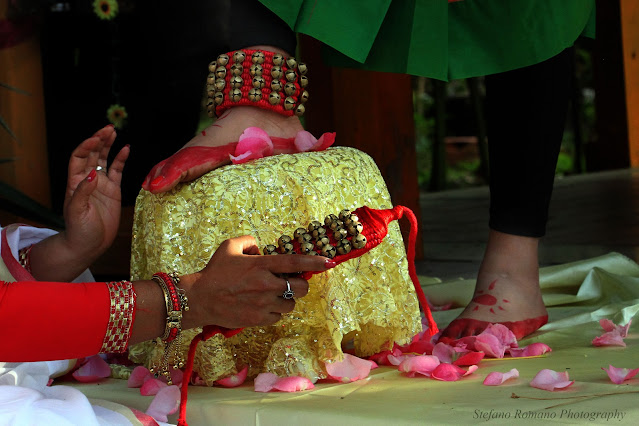

Congratulations for another accomplishment🌹.
ReplyDeleteI can not describe the amazement i was feeling while i was going through the story...seems so real. As if someone was in front of you telling Saanvi's life story while you were jotting it down, and not you, yourself created her, the other characters and the whole plot.
You have the ability to convey great lessons in life.. You are a totality of a great storyteller.. That is you, my friend!!! Hat's off!!!
Thank you so much, this time I really feel Saanvi as real. It was a long story 🙏
DeleteAs I expected...surely the ending of this story is happy...because every pain has its consequences later.
ReplyDeleteCongratulations on an interesting storyline and such a thorough description.
You are indeed a keen observer...and a perfect presenter .. !!!
Thank you so much, happy you like it ✌️😊
DeleteSo inspiring..best!
ReplyDelete